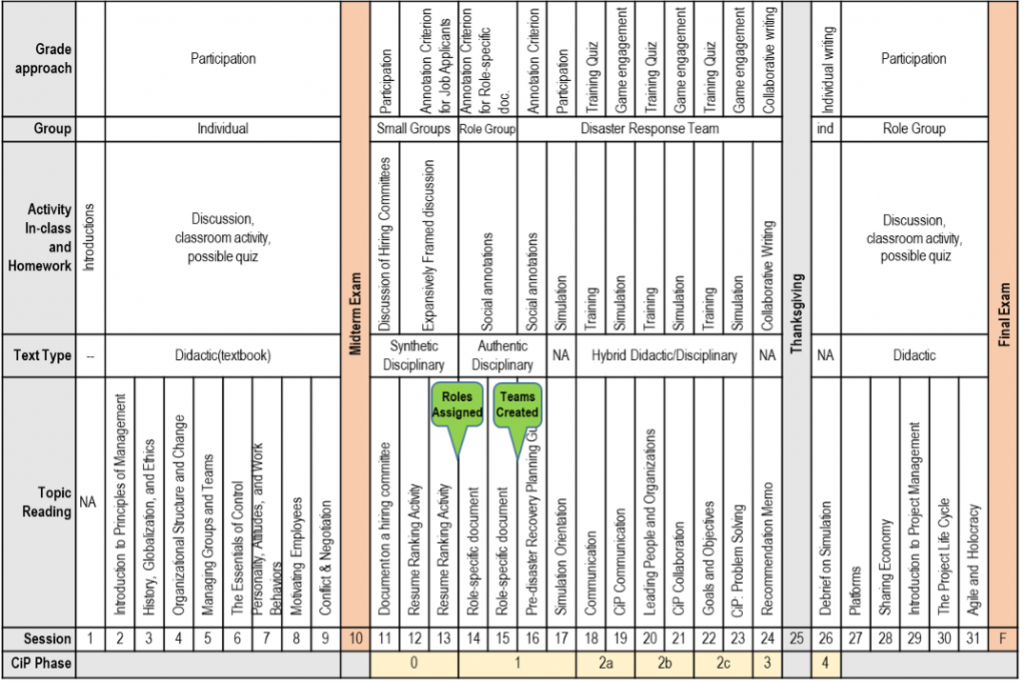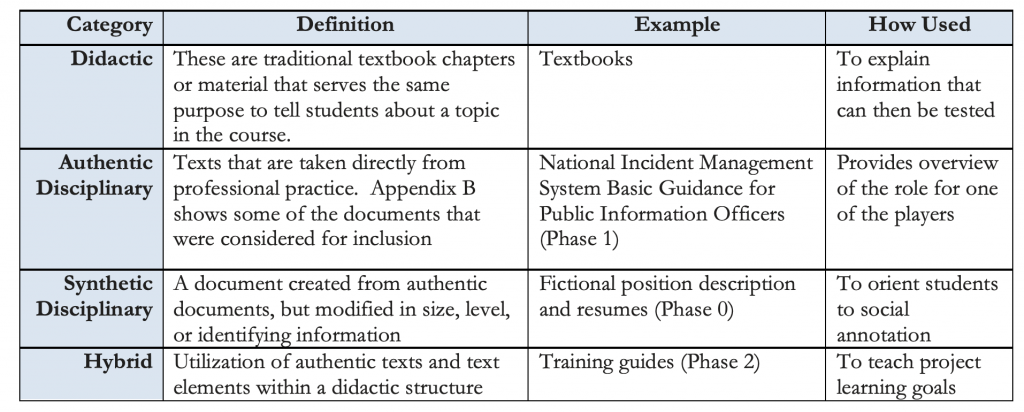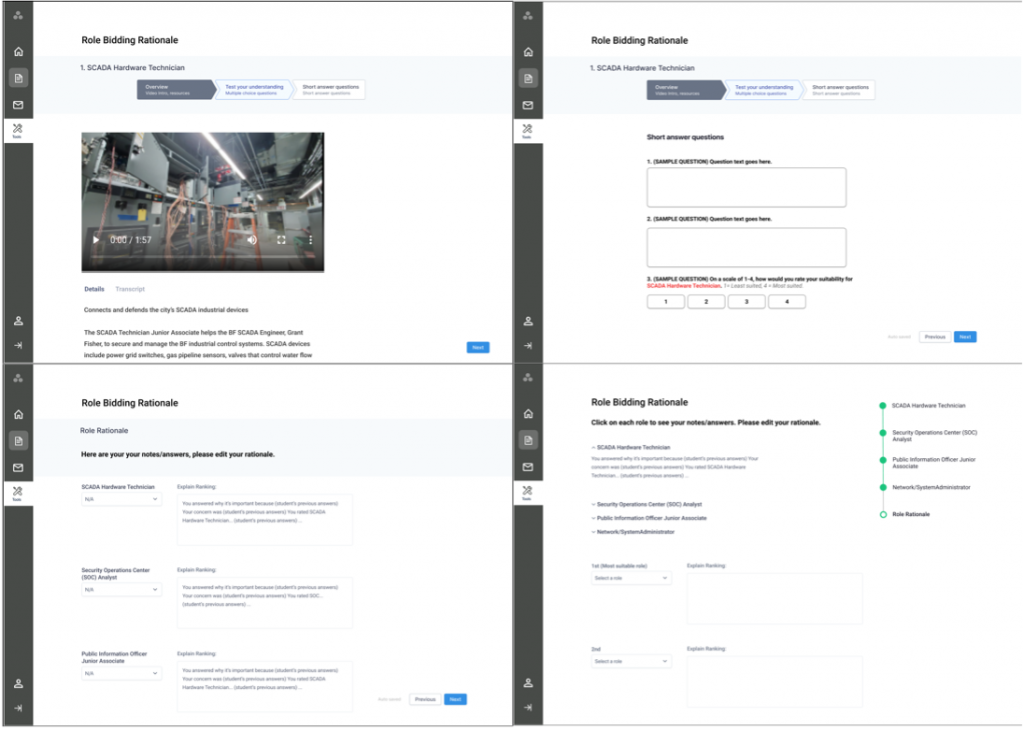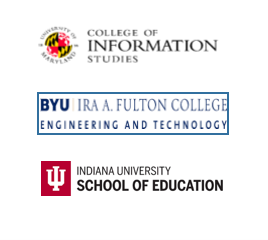Developing a Textual Ecology for Disaster Response
The Disaster Response Playable Case Study (PCS), like its Cybersecurity counterpart, unfolds over several weeks following a phase structure shown in Figure 1.

Figure 1- Disaster Response Phase Structure
Each of these phases will involve some engagement with disciplinary texts—professional documents that are either directly from practice or crafted to represent authentic workplace documents.

Figure 2. Curriculum Planning
Resume ranking activity (Phase 0)
This is one part of the design where a goal for the course that preceded this research project is included in the design. Because many of the undergraduates in University A’s do not come into the university with a strong sense of how to become attractive applicants for future employment, there was a desire to include more emphasis on preparing for a future career into this course. The resume ranking activity has the students pretend to be on a hiring committee and reviewing fictional applicants for a fictional job description. Their ranking and justifications of the ranking is an opportunity to use expansive framing (Engle & Conant, 2002) and to begin to introduce the students into the fictional world of Bronze Falls.
Research role-specific disciplinary documents (Phase 1)
Once the students are given their roles they will be assigned to role groups. These will be clusters of 4-5 students who all have the same role, but at this point do not know what team they will be on or what their role will have them do in the simulation. These documents are not synthetic, but instead drawn from professional work and are typically around 100 pages and composed for people with some training in disaster response. This will be an opportunity for students to see professional work through the lens of these documents.
Comment on a shared interdisciplinary document (Phase 1)
This activity will also use an authentic document that is a guide from FEMA on community response. This work will be done by different roles in the same project group. This group will be the same one that will work together to collaborate on solving problems in disaster response. This social annotation activity will serve as an instructional bridge into their PCS role and ask them to comment together on issues raised in the document. It will also provide a baseline of their communication patterns that may relate to the kinds of communication patterns that are seen in the action of Phase 2 and the reflection of Phase 3.
Learn from training documents with embedded FEMA case studies (Phase 2a-2c)
When the students are working in Phase 2 they will be fully immersed in the narrative and playing their roles within stable teams. The three Phase 2 cycles will act like levels for the players in that the challenge will increase and with that challenge will come additional training about the learning objectives that the phase is to cover (see Appendix A). Phase 2a will involve the players responding to caselets that they learn about through various means. Phase 2a will familiarize the players with the scoring and how they will communicate with each other. Communication is the focus of the training that will occur in this phase segment. Phase 2b will increase the challenges for the players so that they will find caselets that can be addressed by multiple players. The focus of this segment is collaboration and the training will cover those topics using FEMA case studies for examples. Phase 2c will focus on problem solving. In this phase, students will deal with the same kinds of caselets they encountered in the earlier phases, but they will encounter some additional ones that are interrelated in important ways. These caselets will have a common hidden caselet that the team has the opportunity to recognize and respond to.
Recommendation memo (Phase 3)
When the students are working in Phase 2 they will be fully immersed in the narrative and playing their roles within stable teams. The three Phase 2 cycles will act like levels for the players in that the challenge will increase and with that challenge will come additional training about the learning objectives that the phase is to cover (see Appendix A). Phase 2a will involve the players responding to caselets that they learn about through various means. Phase 2a will familiarize the players with the scoring and how they will communicate with each other. Communication is the focus of the training that will occur in this phase segment. Phase 2b will increase the challenges for the players so that they will find caselets that can be addressed by multiple players. The focus of this segment is collaboration and the training will cover those topics using FEMA case studies for examples. Phase 2c will focus on problem solving. In this phase, students will deal with the same kinds of caselets they encountered in the earlier phases, but they will encounter some additional ones that are interrelated in important ways. These caselets will have a common hidden caselet that the team has the opportunity to recognize and respond to.
Individual reflection (Phase 4)
This is an individual assignment intended to elicit important information about the team dynamics and lessons learned. Combined with the other measures the project is collecting, this data will provide insights on the teamwork processes.
Productive Disciplinary Engagement
Productive Disciplinary Engagement (PDE) is an approach to the use of language to teach about a profession. It has often been used as an approach for spoken discourse, but in this project we are using it with workplace texts. We are attempting to use authentic documents drawn from organizations like the Center for Disease Control (CDC) and the Federal Emergency Management Agency (FEMA) and their local counterparts to show the students what it means to work with in a STEM career focusing on disaster response.
Text Typology
The students engaging with the PCS will be given access to authentic documents along the way to scaffold and guide their journey through the PCS experience. Closely aligned with the learning goals forwarded in the NSF proposal, the text/documents team is working hard to develop textual resources that closely resemble STEM workplace documents. We are targeting the key learning goals: Understanding of Roles, Communication, Collaboration, and Problem Solving.

As an illustrative example, we have created a module on “Communication in Disasters.” The module introduces students to the importance of maintaining communication flows with team members in disaster management. Further, through a case study drawn from FEMA, the students will learn how communication across other agencies, community organizations, and the public is crucial during and after a disaster event. The module also contains two models of communication. The first one relates to the steps involved in communicating with the public. The second one explains the interrelations among human psychological factors that play a role in disaster communication and reception.
Refining the Design of the Cybersecurity Dashboard
Our PCS development team and Content and Learning Resources team are working hard to ensure that cybersecurity PCS will be ready to run in the classroom next month. Now the Content and Learning Resources team is working on finalizing content and learning resources for the PCS, and developers add the content to PCS’s dashboard. We are also working on refining the features and UI of the current dashboard interfaces. For example, we started rethinking the Role Selection Process, where the players review each role in the Cybersecurity PCS and then provide a rationale for which one they think fits them best. We explored some design ideas to help players choose their roles and decided to have the following options on the Role Ranking dashboard: 1) the descriptions of each role, 2) links to external resources, videos, 3) Role-specific questions, 4) Role ranking, and rationale. In the latest design variations, we rearranged the layouts and added features like a progress bar to show the process and allow players to see their answers from role-specific questions on the final role ranking page.

Figure 4. Cybersecurity Dashboard
Team Member Spotlight: Bryan Hwang
Bryan just graduated from the iSchool this past winter, with a BS in Information Science and a specialization in Data Science. Currently, he is involved with CIP’s software development for Learning Analytics. He has been managing the API (which receives and sends game data) and working on integrating it with the Playable Case Study. Bryan’s main work has been allowing for proper storage of information into the API’s database, and creating a way for users to extract that information.
Usually, he works with all the developers to coordinate timelines and provide debugging support, primarily working with Python and MySQL. In his free time, Bryan plays video games and strategy board/card games.

Figure 4. Bryan Hwang
Careers In Play Leadership Team
Phil Piety, PhD. University of Maryland iSchool (PI and Learning Analytics). ppiety@umd.edu
Beth Bonsignore PhD. University of Maryland iSchool (Co-PI and Design-based Research), ebonsign@umd.edu
Derek Hansen, PhD.Brigham Young University (Co-PI and Game Technology). dlhansen@byu.edu
Dan Hickey, PhD. Indiana University School of Education (Co-PI, Learning Theory and Assessments). dthickey@umd.edu
